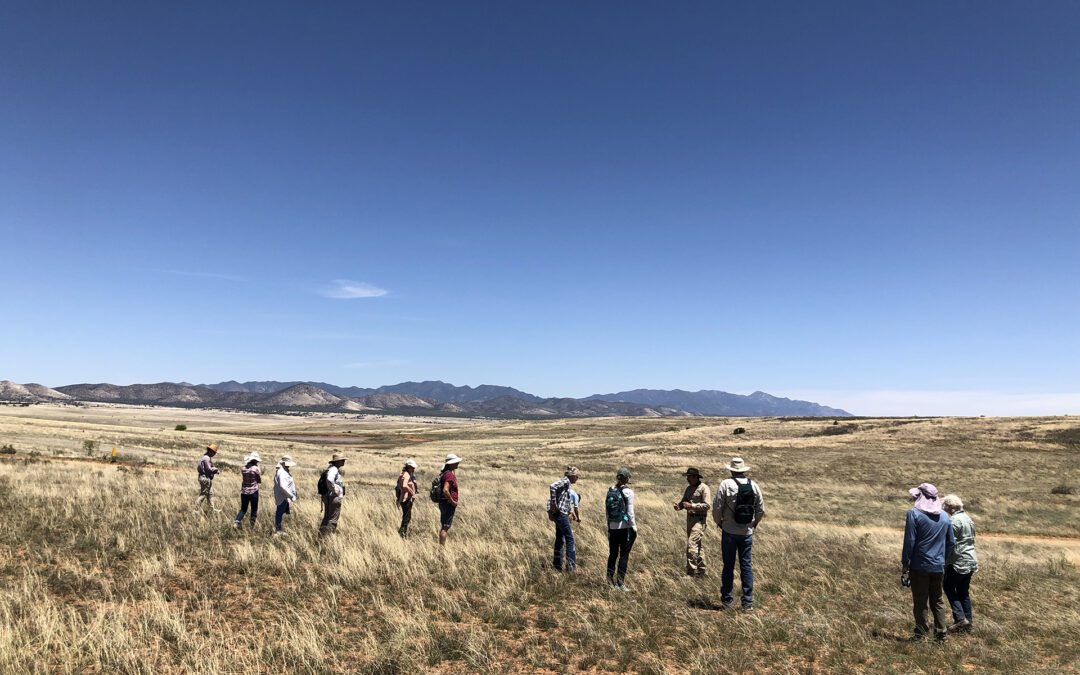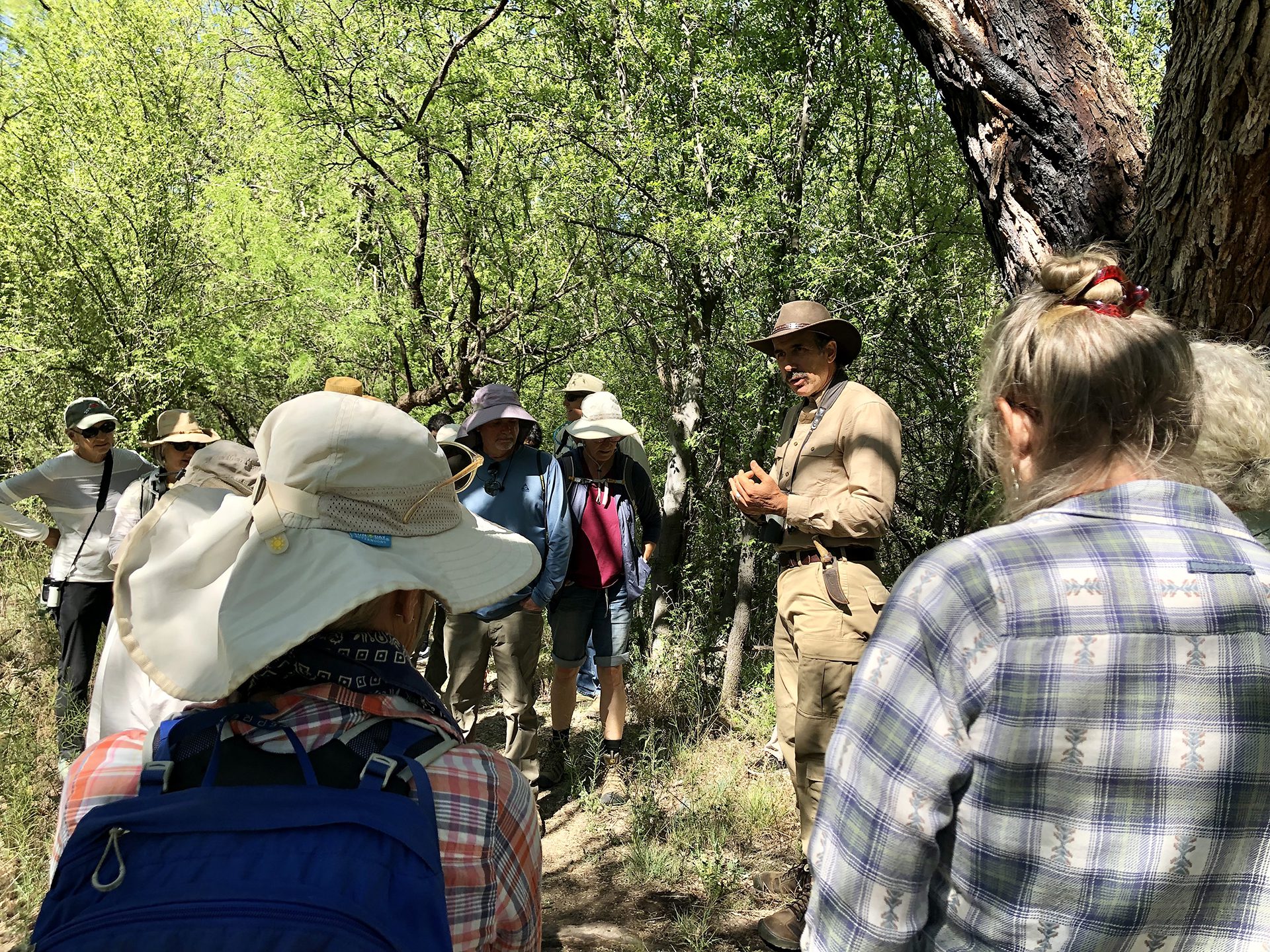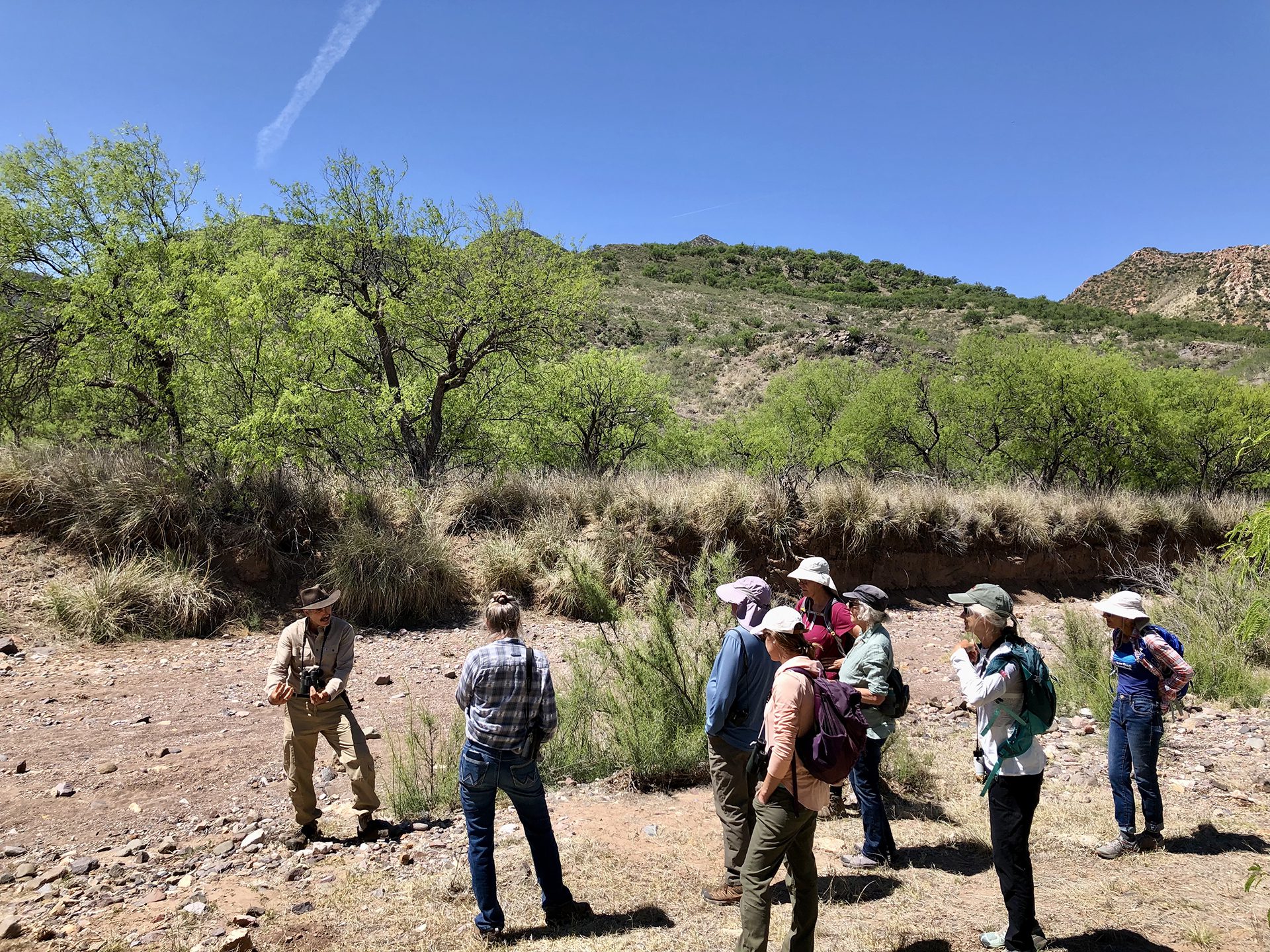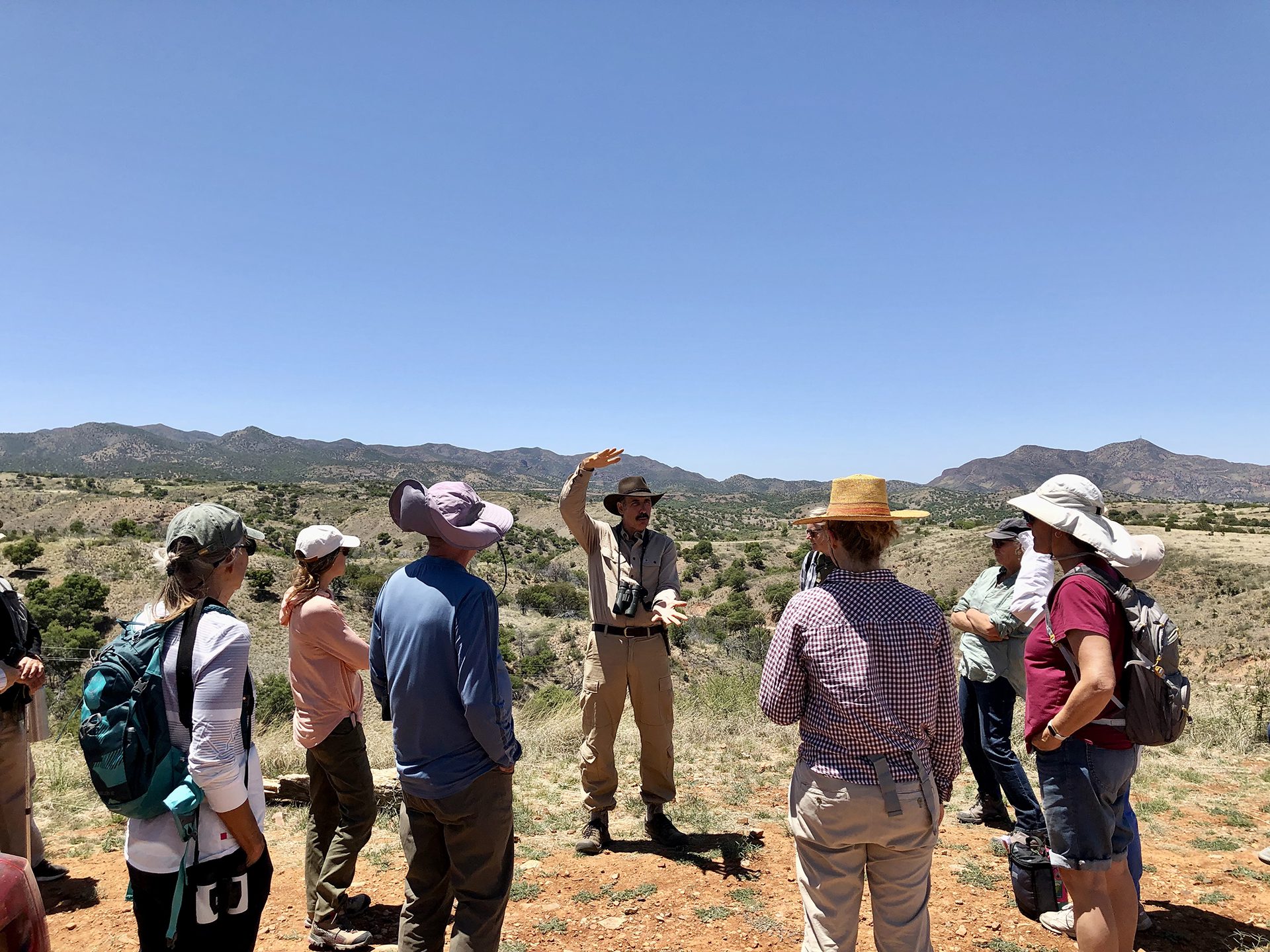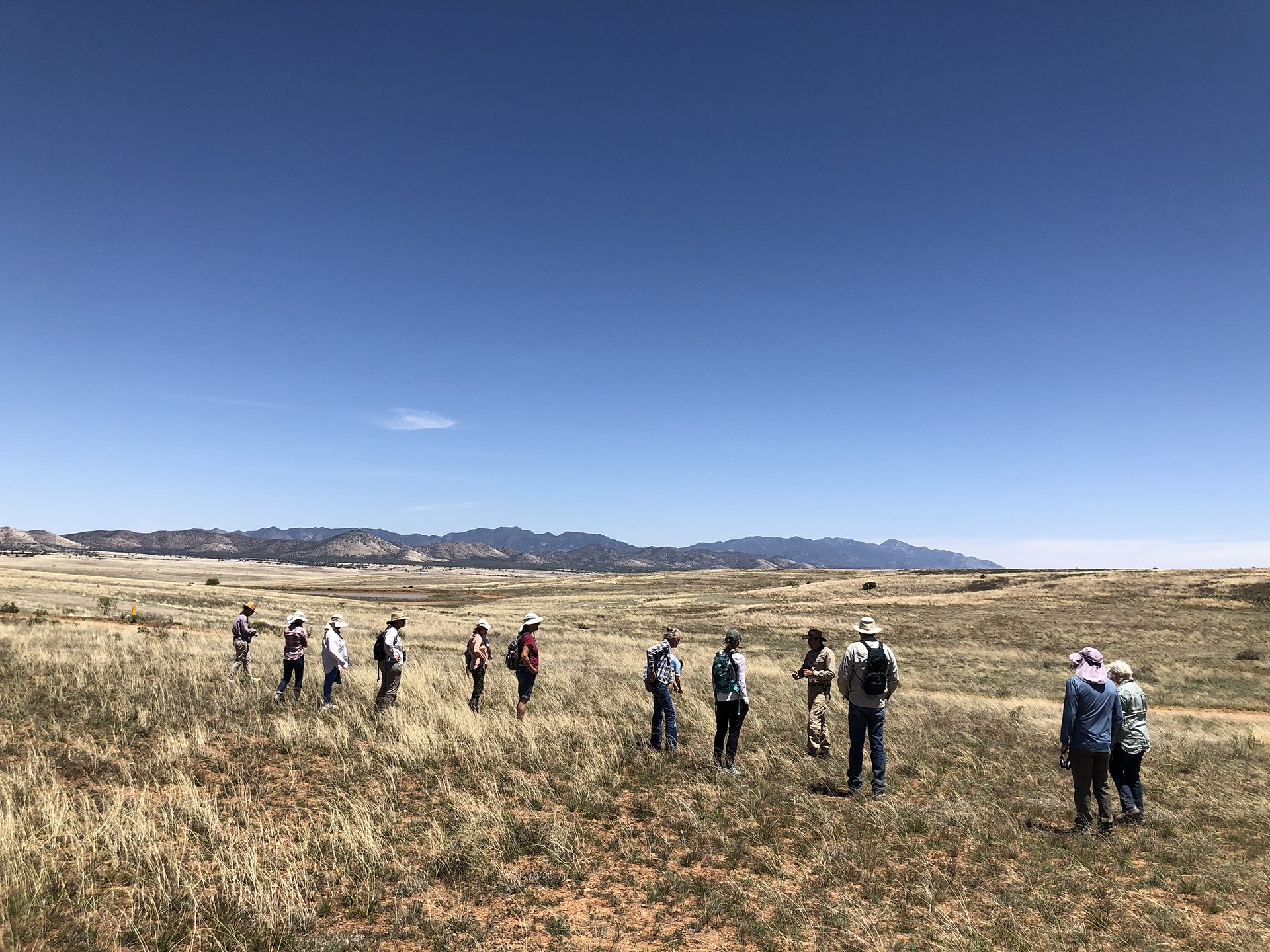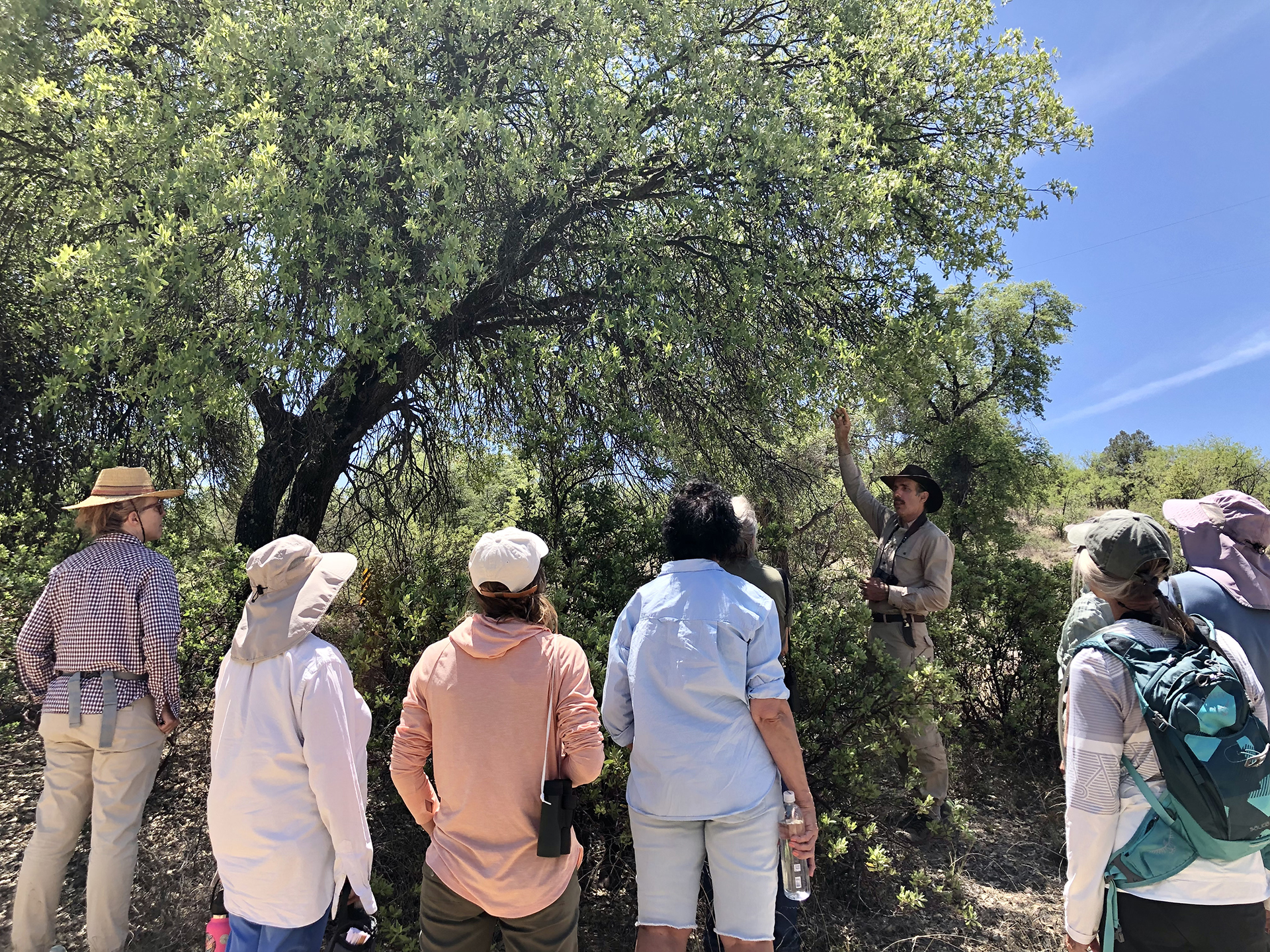by Vincent Pinto
In conjunction with PARA’s new film, Biodiversity in the Heart of the Sky Islands, a fund-raising raffle was held for 15 slots in a Biodiversity walk in and near the Patagonia Mountains. As part of our crucial mission to save the range and the associated Sonoita Creek Watershed from the worst assaults of industrial mining, PARA is striving to educate people near and far about the high levels of biodiversity in the region. Thus, on May 6th, from 8am until 1:30 the winners of the raffle joined me for an indepth tour of some key biodiversity hotspots near the town of Patagonia. It was an enthusiastic group full of excellent questions and high levels of interest. Collectively, we saw, heard, and otherwise experienced a serious dose of our much vaunted flora and fauna. Even before we departed the parking lot of the Patagonia Post Office, many of us admired several Common Ravens in full puffy-headed displays, as well as a slew of far-off Turkey and Black Vultures. A few Barn Swallows, no doubt nesting on buildings in town, strafed the sky just above our heads.
After an overview of the Sky Islands region we first explored the Nature Conservancy’s Sonoita Creek Preserve. Thjere we made a beeline for the rare and biologically intriguing cienaga that is situated near the northern edge of the park. En route we admired the insect hawking of a male Vermillion flycatcher – always a crowd-pleasing beauty! Its cousin, a peach-bellied Say’s Phoebe hunted nearby from a set of solar panels. A small armada of tiny Rough-winged Swallows glided effortlessly through the sky overhead, snagging insects in non-stop flight. A few lingering California Poppies near the trail reminded us that winter precipitation had been abudant this year. Meanwhile, I cautioned everyone to take heed of periodic cleared spots on the ground – telltale signs that potent-stinging Red Harvester Ants lurked underground. Towering Fremont Cottonwoods served as our navigational beacon, as we neared the fringes of the cienaga. Suddenly, what had been a field full of nonnative, invasive plants transformed into wet plains dominated by sedges and other native flora.
Passing by a few Black Elderberry trees and a small stand of California Coffeeberry shrubs, we finally strode under a dense canopy of the Cottonwoods, Southwestern Black Willow, Velvet Ash, Netleaf Hackberry, and Arizona Walnut – a veritable who’s-who of native deciduous riparian trees in the Sky Islands. All exhibited healthy levels of recruitment in the form of saplings and seedlings. Meanwhile, birds continued their morning chorus: Dusky-capped Flycatchers, Yellow-breasted Chats, Lesser Goldfinch, Yellow Warblers, Common Yellowthroats, Northern Cardinals, and other species formed a pleasant auditory backdrop to the cienaga. A White-breasted Nuthatch silently slunk down a treetrunk to the side of our group.
Clearly, everyone in the group was entranced by the magic of this swampy and marshy habitat – a truly rare environment in the the Sky Islands. Crushing the leaves of Yerba Mansa, an odd plant in the Lizardtail family, we all marveled at its pleasant and aromatic scent. Senses fully engaged, we meandered slowly through this emerald forest. I pointed out a gobbling Mexican Wild Turkey tom and his female entourage at the fringe of the marsh. These iconic, gallinaceous birds have made a roaring comeback the the region via reintroduction efforts and habitat protection. Ben Franklin would no doubt approve.
Early on I pointed out the haunting cries of a pair of Gray Hawks, a neotropical buteo that barely enters the U.S. Up till now they had proved elusive. Finally, we spotted the male and female in tandem flight, no doubt near their treetop nest. The unseen lizards that scurried periodically throught the dense leaflitter certainly have cause to be nervous with this hawk on the prowl. Nearby, we inspected a small patch of False Indigo shrubs plopped in one of the wettest sections of the cienaga. This plant in the bean family normally grows much higher up in the mountains.
Reluctantly taking leave of our improbable forest, we next traveled the still heavily-treed corridor of the Railroad trail at the preserve. There, we admired tall Velvet Mesquite Trees, including one with a Milkweed Vine straggling up its trunk. This herbaceous plant is one of the hosts of the Queen butterfly – close cousin of the famous Monarch – which we observed in flight soon thereafter. While birds certainly ruled the roost early in the day, mammals were soon heard from as well. Pausing by some chalky-white scat, I elucidated as to why it came from a Mountain Lion, which are sometimes observed even by day in the park. One of its main prey items, a Collared Peccary, had likewise deposited scat nearby, albeit more recently. Before we knew it, we were scrutinizing two of these Javelinas as they consumed aquatic vegetation along the fringes of a beautifully flowing Sonoita Creek. Overhead, a silent and sleek Arizona Gray Squirrel deftly manuvered through the dense tree canopy. I took the opportunity to inform the group that Arizona in fact has more tree squirrel species than any other U.S. state!
As the day wamed up, more Butterflies started to get in on the action. Several Checkered Whites floated by here and there. With various mustard species – their larval food source – sometimes dominating the preserve’s fields, this came as no surprise. A lone Black Swallowtail streamed by at a fast clip. The foul-tasting species that it mimics – the Pipevine Swallowtail – also made a cameo appearance along with an Orange Sulphur. This year’s fine wildflower show has spawned a nice diversity of butterfly species.
Drawing upon my ethnobotany background, I pointed out some key differences between Prickly Poppy, many of which were in full bloom, and the vaguely similar New Mexico Thistle. The former is toxic, while the latter is highly edible. Later in the day, I demonstrated exactly how to pick, prepare and consume a leaf of the thistle – only a spectator sport for today’s group. Near the end of our time at the Nature Conservancy preserve we heard what sounded like the piping of a pair of broken smoke alarms. As a Bird Guide, I know this call well, and soon was pointing out several Abert’s Towhees to the group. Before leaving, we mused over the ancient uses of the small native tree, Texas Mulberry – as source of food, fiber, and bow-wood alike.
Off to a great start, we next drove to the Arizona Trail parking lot in the Patagonia Mountains. This afforded us a complete shift in habitats, with only minor overlap in the species we encountered. This area is dominated by large Velvet Mesquites, often with a dense understory of Big Sacaton and other native grasses. Carefully winding our way through the maze of Sacaton, lest we unduly spook a Rattlesnake, we listened to the metallic trills of several Black-throated Sparrows, which often nest in such habitat. Similarly, we heard a diminuitive Verdin calling nearby. They too nest in these Mesquite Woodlands. Several new wildflowers for the day came to light – magenta Trailing Windmills, orange Sidas, yellow Fendler’s Dandelion, and the aptly-named Golden Smoke among them. Meanwhile, we all took care not to run afoul of the wickedly spined branches of Catclaw Mimosa or “Wait-a-minute” bush – a leguminous species that readily attracts butterflies and other pollinators when in bloom.
When a medium-sized Sonoran Spotted Whiptail sunned itself to the side of the arroyo for all to see, I discussed the non-sexual reproduction of this species, termed parthenogenesis. In other words, the entire species is female, who give birth via unfertilized eggs to more females. Definitely the most bizarre species encountered today!
Ants soon made a revival – no suprise since our Sky Islands region hosts more species than any comparable area in the U.S. Tiny Crazy Ants that stormed in a tight column over the ground bear a name that reflects their rather erratic movements., not to mention their penchant for getting into houses and food. Relative behemoths, Long-legged Ants marched in and out of their sloppy nest entrance near Harshaw Creek’s now dry arroyo. This common species has been know to drop pebbles down the nest enrty holes of the Red Harvester Ants – presumably a spiteful behavior aimed at slowing down the competition. Even a second species of Pogonomyrmex, the Orange Harvester Ant, showed up in the arroyo itself, as did both Bordered Patch and Texan Crescent butterflies. Dense creek-bottom patches of the visually nondescript, yet powerfully pungent shrub Arroyobush or Burrowbrush, offered protection from erosion during the floods of monsoon season. Likewise, a lone and rather young Arizona Sycamore had tethered itself near the bulwark defense of a large boulder embedded in the arroyo’s bottom. There the two now conspired to form an island around which floodwaters will likely part.
Wresting our eyes from the ground, we observed a small clone of western Soapberry trees dominating a small rock outcrop that lorded over the western edge of the creek. I have on a number of occasions indeed made soap from their attractive, translucent yellow fruits. Higher up Red Mountain loomed both dense riffs of Interior Chaparral and taller Madrean Evergreen Woodland – a preview of the next two habitats we would visit. Zooming in closer again, I pointed out a healthy clump of Desert Mistletoe – a native succulent, epiphytic shrub adorning a large Velvet Mesquite’s higher branches. I took the opportunity to point out the high wildlife value of this often unjustly maligned plant. The fat-laden fruits and bird nesting opportunities afforded by its dense cluster of branches far outweigh and minor damage it may cause to its host tree. Earlier, we had briefly observed one of the main partakers of the Mistletoe’s fruit – an exotic-looking male Phainopepla. Nor were they the only fruiting species in evidence today. A number of densely spiny Graythorns, mostly growing in the Mesquite understory, had still-ripening fruit – a promise of vital bird food in the near future. With relatives in tropical Africa, the Graythorns lent a somewhat tropical air to the Mesquite Woodlands.
Down the road, a quick stop atop a hilly crest afforded us nice views of Madrean Evergreen Woodland which was dominated by Emory Oak in this particular location. Given the wet winter, these oaks were already decked out in fresh leaves. Drought years see them solely dropping leaves in spring, then waiting until monsoon season to once again leaf out. Emory Oak have acorns that ripen in June – a boon to many species of wildlife in a notoriously austere and sere time. Melding seemlessly into the woodland component of the habitat was some Interior Chaparral dominated by Pointleaf Manzanita, a member of the Heath family along with their cousins, Blueberries, Rhodedendrons, and Azaleas. Their hard-pitted fruits were just getting a blush of color. Their slow ripening continues through summer, when a long list of mammal and bird species partake of the sweet-tart fruit of this “little apple”.
An upstream section of Harshaw Creek furnished us with another key biodiversity stop for our group. Exploring above and within the still dry confines of the arroyo, we witnessed a rather stark shift from the downstream locale. This higher, cooler, and more sheltered site suddenly had Oaks, mostly Gray Oaks, as well as mature Arizona Sycamores. Dense patches of vining Poison Ivy suprised some of the group who did not expect to find this species in the Patagonias. Its close cousin, 3-leaf Sumach sometime grew cheek-by-jowl with it beneath the Oaks. The sumach was and is a key basketry plant for many Southwest Native Nations. Neon pink splashes of Dakota Verbena adorned a few spots above the creek, as did less gaudy, yet still attractive Spreading Fleabane flowers. Several participants followed my lead and smelled the aroma of the Verbena, which is eerily reminiscent of hot chocolate!
In a cautionary tale, I pointed out that a number of large Arizona Walnuts had recenty died of causes unknow along one side of the creek. The presence of trees in the Patagonias and along Sonoita Creek is no given in even the near future. With the current and upcoming challenged posed by both global warming and willy-nilly water use by mines in the Patagonias we are playing ecological Russian roulette with our woodlands and forests. Before we blink a proverbial eye, we could easily lose many of our local trees.
Down in the dry creekbed, we circumnavigated a large boulder embedded in the ground. Its surface was heavily covered in brightly colored Crustose Lichens of at least 3 species along with some dessicted Moss. Desert Willow trees grew straight out of the arroyo, prompting a telling question. One person aked if it was a native tree. I pointed out that not only was it native, but that it also supported a bevy of wildlife, including Hummingbirds. We would have come a long way when the answers to such questions is common knowledge. Learning about our biodiversity is certainly a prerequisite to understanding and hence protecting it. In this regard, ignorance is certainly not bliss.
Despite the later hour, birds soon made a minor resurgance. A clownish-looking Acorn Woodpecker clung jealously to a bare tree trunk high above us. Only periodically did it feign to move. Saving energy is often as good or bettern than securing it via hunting. Its close cousin, a Gila Woodpecker, called nearby. Both are key architects, whose old nesting holes become domiciles for a number of spcies who are unable to construct such abodes. Other birds were busy nearby – an Ash-throated Flycatcher and a floaty-flighted Cassin’s Kingbird both near a large Sycamore where they were prowling for insects.
With time running out, we swiftly headed for our final destination – a sort of cherry on top of an incredible day spent exploring our magnificent biodiverstiy. As we neared the top of a hill that leaves the Patagonia Mountains, we noticed a patch of Cliffrose setting seeds from its recently copious white flowers. Soon we were striding through the flower-covered San Rafael Grasslands, which skirt the southern edge of the Patagonias. With nary a bird to observe, save the rare flushing Grasshopper Sparrow, we were liberated to focus on the many blossoms. Greene’s Lotus, Plains Flax, Wavyleaf Thistle, Rock Daisy, Spreading Snakeherb in the Acanthus family, Blue Dicks, Range Ratany, Slender-Flower Indian-Breadroot, a pink-flowered Dalea, and some waning Locoweed, all came to the fore. Meanwhile a lone baby Rainbow Cactus was uncovered by one of our explorers. Several young Alligator Junipers punctuated a few spots in the grasslands, as did patches of the succulent Sotol. Each of these mini habitat islands accentuated the idea that this “sea of grass” holds more than meets the casual eye.
Not long ago in the scheme of things, Geronimo and Cochise used the tall, dried flowering stalks of Sotol as sprear shafts during warfare. Back then Mexican Wolves, Mexican grizzlies, Aplomado Falcons and other now locally extirpated species roamed our area. Thus, I brought our biodiversity foray to a close with mention of these key and now missing species. We all agreed that what we know, we can love. What we love, we will strive top protect….and what we protect will enrich our lives. I thanked all present for their interest in and concern over the varied life of this much-imperiled area. By supporting PARA, these stellar people have spoken not only with their hearts, but also with their wallets. They and many others are helping to fight the looming impacts of industrialized mining in an area that should have no mines at all – the real treasure lying in the biodiversity of this much imperiled Sky Island.
With warm farewells, we reluctantly parted ways, all the richer having delved deeply into the biodiversity for which our Sky Islands area is rightly acclaimed.

